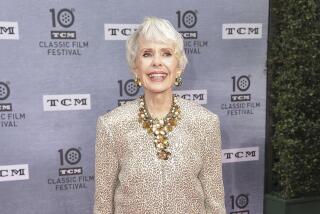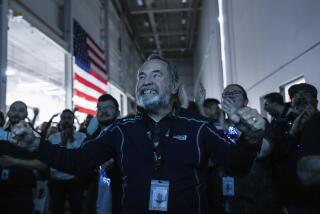Joan Archer Aldrin dies at 84; dealt with the spotlight as astronaut’s wife
In the 1960s, few American women were placed on a higher pedestal than the wives of the nation’s astronauts.
They were symbols of feminine poise, perfectly coiffed mainstays of the home front who waved the flag and raised the children while their husbands raced into space. A launch-day photograph of three smiling wives from the Apollo era seemed to say it all: “Proud, Thrilled, Happy” read the signs they held high.
Joan Aldrin, whose husband, Buzz, became the second man to walk on the moon in 1969, felt all of those emotions — and some that she was unprepared for.
“I had married an engineer and here he was a hero,” she told The Times a few years after her husband’s historic Apollo 11 mission with Neil Armstrong and Michael Collins. “This was disturbing but I didn’t understand and my immediate reaction was anger toward Buzz. I did realize I should have expected it.”
Aldrin, who spoke frankly about the stresses of life as an astronaut’s wife for two decades, died July 22 in Ventura of natural causes, her family said. She was 84.
“The future will recall Joan Archer Aldrin as a soft-spoken wife and mother, raising three well-behaved, individual-minded children and dealing with both our … tribulations with a most admired human acceptance,” Buzz Aldrin, 85, said in a statement Thursday.
Joan Aldrin belonged to an elite club that brought unique perks as well as responsibilities.
“To be an astronaut wife meant tea with Jackie Kennedy, high-society galas, and instant celebrity,” Lily Koppel wrote in “The Astronaut Wives Club,” a 2013 book about the women who stood beside some of the most iconic figures of the past century. “When their husbands … were chosen to man America’s audacious adventure to beat the Russians in the space race, they suddenly found themselves very much in the public eye.”
TV crews camped on their lawns and sometimes in their living rooms to record their reactions during agonizing hours and days waiting for their husbands’ safe return.
When the missions ended, the challenges continued as they grappled with sudden fame and the letdown of life back on Earth.
Buzz Aldrin, whose July 20, 1969, moon walk was televised to millions around the world, struggled with alcoholism and depression and had extramarital affairs. Like many astronaut marriages, the Aldrins’ ended in divorce.
He went on to write books about his space explorations and the consequences of stardom. His wife did not recede into the background.
“I feel my story is just as important to tell,” she told The Times in 1973 when she gave her first solo interview.
“There’s something about the public making a hero of a man, what it did to him and me and the kids,” Aldrin said. “Maybe these things have been behind closed doors too long. They’re not unusual. It’s only unusual that we’re talking about them.”
Joan Ann Archer was born in Paterson, N.J., on Dec. 5, 1930, the only child of oil executive Michael Archer and C. Evelyn Cleminshaw. After acting in high school productions, she studied drama in college, earning a bachelor’s degree from Rutgers University in 1951 and a master’s from Columbia University in 1953.
Buzz Aldrin was an Air Force lieutenant when she met him in the early 1950s. They were married in 1954.
She found the first year of marriage difficult with her quirky pilot husband, who gave her an unruly monkey named PoPo II as a Christmas present and was in the air more than he was at home. “I was always alone,” she recalled to Koppel.
His personality compounded her sense of isolation. “Men don’t really chatter as women do, and Buzz is not a man who talks a lot,” Aldrin said. “I am a talker, and I am very direct. It was hard for me, not to have him there to talk to.”
When he joined the space program in the early 1960s, she joined the circle of astronaut wives in Houston. The women met regularly, forming a sisterhood whose members supported one another through the thrills and perils of space flight.
“If you think going to the moon is hard, trying staying at home,” Barbara Cernan, whose husband, Gene, commanded the Apollo 17 mission, said in Koppel’s book.
Aldrin found some release from the pressures in a theater group near their home.
“Buzz didn’t want her to be part of it, to be the weird theater wife,” Koppel said in an interview Friday, “but Joan had to be herself. She really stood out as an exceptional, original character.”
Space disasters, however, remained a constant worry.
“I wish Buzz were a carpenter, a truck driver, a scientist, anything but what he is,” Aldrin told Life magazine in 1969, recalling her thoughts while waiting to hear if he would be named to the Apollo 11 team.
A short time later, a photographer captured her expression as the lunar lander touched down on the moon. She is shown turning her face away from the television — in joy, terror or a mixture of both.
After the crew’s triumphant return, Joan Aldrin and the other wives joined them on a world tour. They met Pope Paul VI in Rome and presented a moon rock to Queen Elizabeth. Everywhere they went the astronauts attracted throngs of female admirers.
“I always felt the curtain will come down and we will have a normal life,” Aldrin told KPPC radio host Larry Mantle in 2013. “But that never really happened.”
After her divorce in 1974, she went to work as an administrator at ABC television in Los Angeles. She left in 1998 and spent her last years in a retirement home, where she directed a play reading group.
She is survived by three children, James Michael Aldrin, Janice Ross Aldrin and Andrew John Aldrin; a grandson; and two great-grandchildren.
Twitter: @ewooLATimes
More to Read
Start your day right
Sign up for Essential California for the L.A. Times biggest news, features and recommendations in your inbox six days a week.
You may occasionally receive promotional content from the Los Angeles Times.







